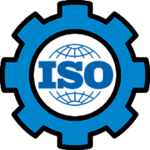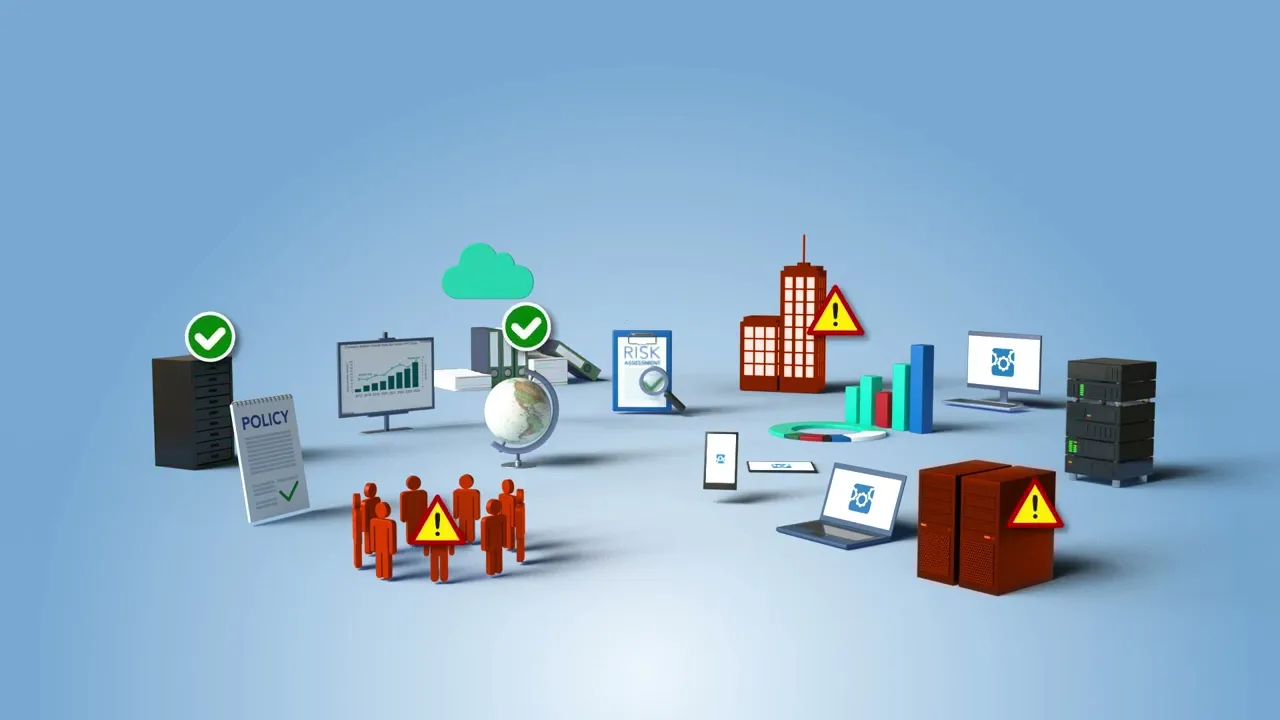Your Roadmap to Risk Reduction!
Table of Contents
ToggleThe Continuum GRC ITAM SaaS platform has hundreds of plugin modules available, such as:

International Organization for Standardization (ISO) 27001
Continuum GRC created the number one-ranked IRM GRC audit software solution for ISO audits that empowers you to prepare for an ISO audit effectively while dramatically reducing costs in preparation for working with a third-party assessment organization.
The International Organization for Standardization (ISO) 27001 is a globally recognized standard for information management security systems. It gives organizations a clear framework for establishing, implementing, and maintaining what they need to protect their sensitive information. ISO 27001
Offers a practical and structured approach to identifying and implementing the security controls they need.
Modules include:
- ISO 27001: Information Security Management System (ISMS)
- ISO 27002: Supports the requirements of ISO/IEC 27001
- ISO 27005: Information security risk management
- ISO 27017: Information security for cloud services
- ISO 27018: Protecting personal data in the cloud
- ISO 27701: Privacy Information Management System (PIMS)
- ISO 22301: Business Continuity Management Systems (BCMS)
- ISO 17020: Requirements for the competence, impartiality, and consistency of inspection bodies
- ISO 17021: Requirements for the competence, consistency, and impartiality of bodies providing audit and certification of management systems
- ISO 17025: Competence of testing and calibration laboratories
- ISO 17065: Requirements for bodies certifying products, processes, and services
- ISO 9001: Quality Management Systems (QMS)
- ISO 90003: ISO 9001:2015 to computer software
- ISO 42001: Artificial Intelligence Management System (AIMS)
ISO 27001 Audit for Security
An ISO 27001 risk assessment, or audit, evaluates an organization’s readiness in protecting sensitive information and securing its data and assets as they pertain to ISO standards. The audit reviews the current risk management process, existing security controls, best practices, and more that an organization uses to protect its data. Then it makes expert recommendations for strengthening the infrastructure, internal controls to ensure the highest levels of security and privacy protection.
Undergoing this risk assessment process not only hardens your information security but also demonstrates to stakeholders and customers your commitment to data protection.
Key Steps Involved
The main steps to an ISO 27001 audit begin with the scope: what processes, data, and assets fall within ISO requirements? Next, review the existing documentation around those assets to identify risks and how they match up against ISO requirements. Collect related evidence. Find an external auditor, such as Continuum GRC, to prepare any necessary documents and conduct the audit. Analyze the findings from the risk assessment and establish an appropriate risk treatment process, implementing the changes to address any non-conformance.
Maintain compliance through regular monitoring and reviews. Conduct internal audits to ensure your organization is on point with the requirements of ISO 27001.
FAQ
How many ISO 27001 controls are there?
There are 93 controls that are checked during an ISO 27001 risk assessment. These are divided into four basic groups: organizational controls, people, physical, and technological. These particular controls are used to examine different aspects of your organization’s information security and practices.
Who needs to comply with ISO 27001?
While it’s not mandatory, ISO 27001 compliance is for any organization that prioritizes the security of information and wants to show a commitment to protecting their sensitive data. It’s a “best practice” for any business, but especially for those dealing in finance, healthcare, IT, telecommunications, and government.
What’s the difference between ISO and NIST?
These are both frameworks for cybersecurity, but they differ in their scope, certification, and the approach in which that certification is achieved. NIST uses their free framework primarily for federal agencies and related organizations. ISO standards are internationally recognized, but require a fee for documentation and certification.
Who can audit ISO 27001?
An ISO 27001 audit should be conducted by qualified and accredited third-party auditors that have expertise in the particular standards of risk assessment. They should be trained in the very specific and most current aspects around information risk, and must be able to show experience in understanding the compliance standards.
How does an ISO 27001 risk assessment support compliance?
An ISO 27001 risk assessment supports your organization’s compliance by identifying and then prirotizing your particular security risks. This is the heart of this form of compliance. Understanding your organization’s key vulnerabilities allows you to then create a smart and thorough risk treatment plan to protect those assets.
How often should an ISO 27001 risk assessment be conducted?
A risk assessment should be conducted annually at the very least. However, more frequent risk assessments are recommended when big changes are made in your organization, particularly involving IT infrastructure. A risk assessment should be done on an ongoing basis just to stay on top of evolving threats.
What are you waiting for?
You are just a conversation away from putting the power of Continuum GRC to work for you.
Contact us using the form below or calling us at 1-888-896-6207 for immediate assistance.
To reduce spam submissions, we’ve implemented email verification for access to this form.
How it works:
- Enter your email address below.
- We'll send you a unique verification link.
- Click the link in the email to confirm your identity and gain access to the form.
This ensures only verified users can proceed, helping keep responses genuine and spam-free.
Thank you for your cooperation! If you don't receive the email, check your spam folder or request a new link. If you prefer to speak with a REAL HUMAN, please call our number listed at the top of this page.
If you are seeing this message and not the intake form, you still need to validate your email address.
If you have received this message in error, please contact us using the telephone number listed on our website for assistance.
About the Standard
ISO/IEC 27001 is an internationally recognized standard for establishing, implementing, maintaining, and continually improving an Information Security Management System (ISMS). Published by the International Organization for Standardization (ISO) and the International Electrotechnical Commission (IEC), it provides a systematic and risk-based approach to managing information security to protect the confidentiality, integrity, and availability of sensitive information. Below is a compliance overview of ISO 27001, detailing its purpose, scope, requirements, and key considerations.
Purpose of ISO 27001
ISO 27001 aims to:
- Protect sensitive information (e.g., customer data, intellectual property, financial records) from threats like cyberattacks, data breaches, or unauthorized access.
- Provide a framework for organizations to manage information security risks systematically.
- Demonstrate to stakeholders (e.g., customers, partners, regulators) a commitment to robust security practices.
- Enable certification to enhance credibility and meet regulatory or contractual requirements.
Scope and Applicability
- Covered Entities: Applies to organizations of any size or sector (e.g., private companies, government agencies, non-profits) that process, store, or transmit sensitive information.
- Information Covered: Encompasses all types of information (electronic, physical, or intellectual) under the organization’s control, including personal data, financial information, and proprietary data.
- Voluntary Standard: ISO 27001 is not legally binding, but certification is often required by clients, partners, or regulators (e.g., in industries like healthcare, finance, or government contracting).
Key Components of ISO 27001 Compliance
ISO 27001 is structured around two main parts: the management system requirements (Clauses 4–10) and the security controls (Annex A, aligned with ISO/IEC 27002). Compliance involves establishing an ISMS and implementing controls tailored to the organization’s risk profile.
- Management System Requirements (Clauses 4–10): These clauses outline the framework for building and maintaining an ISMS:
- Clause 4: Context of the Organization:
- Understand the organization’s internal and external context, including stakeholder needs.
- Define the scope of the ISMS (e.g., specific processes, systems, or locations).
- Clause 5: Leadership:
- Ensure top management commitment to the ISMS.
- Establish an information security policy and assign roles and responsibilities.
- Clause 6: Planning:
- Conduct a risk assessment to identify threats, vulnerabilities, and impacts.
- Develop a risk treatment plan to mitigate identified risks.
- Set measurable security objectives.
- Clause 7: Support:
- Provide resources, training, and awareness programs for employees.
- Maintain documented information (e.g., policies, procedures, risk assessments).
- Clause 8: Operation:
- Implement and operate the ISMS, including risk treatment plans and controls.
- Conduct regular risk assessments and update controls as needed.
- Clause 9: Performance Evaluation:
- Monitor, measure, and evaluate the ISMS through internal audits and management reviews.
- Ensure continuous improvement based on performance metrics.
- Clause 10: Improvement:
- Address non-conformities and implement corrective actions.
- Continually improve the ISMS to address evolving risks.
- Clause 4: Context of the Organization:
- Annex A: Security Controls:
- Annex A lists 93 controls across 4 themes (down from 114 in the 2013 version, updated in ISO 27001:2022):
- A.5: Organizational Controls (37 controls): Policies, roles, third-party management, and compliance (e.g., A.5.1.1: Information security policy).
- A.6: People Controls (8 controls): Employee screening, training, and incident reporting (e.g., A.6.1.1: Background verification).
- A.7: Physical Controls (14 controls): Secure areas, equipment protection, and media disposal (e.g., A.7.2.1: Physical entry controls).
- A.8: Technological Controls (34 controls): Access control, encryption, malware protection, and secure development (e.g., A.8.2.1: User access management).
- Organizations select applicable controls based on their risk assessment and document justifications in a Statement of Applicability (SoA).
- Annex A lists 93 controls across 4 themes (down from 114 in the 2013 version, updated in ISO 27001:2022):
- Risk Management:
- ISO 27001 requires a risk-based approach, aligned with ISO 31000 (Risk Management).
- Steps include:
- Identify assets, threats, and vulnerabilities.
- Assess the likelihood and impact of risks.
- Select controls from Annex A or other sources to mitigate risks.
- Document residual risks and obtain management approval.
- Certification Process:
- Stage 1 Audit: An accredited certification body reviews ISMS documentation (e.g., SoA, risk assessment, policies) to ensure readiness.
- Stage 2 Audit: Auditors assess the implementation and effectiveness of the ISMS through interviews, system reviews, and evidence collection.
- Certification: Upon successful audits, the organization receives an ISO 27001 certificate, valid for three years with annual surveillance audits.
- Recertification: Required every three years to maintain certification.
- Documentation Requirements:
- Mandatory documents include:
- ISMS scope (Clause 4.3).
- Information security policy (Clause 5.2).
- Risk assessment and treatment methodology (Clause 6.1).
- Statement of Applicability (SoA) (Clause 6.1.3).
- Risk treatment plan (Clause 6.1.3).
- Internal audit results and management review records (Clauses 9.2, 9.3).
- Additional documented procedures (e.g., incident response, access control) as needed.
- Mandatory documents include:
- Continuous Improvement:
- Organizations must monitor the ISMS, address non-conformities, and update controls based on new risks, incidents, or business changes.
- Regular internal audits and management reviews ensure ongoing compliance.
Key Compliance Steps
- Define ISMS Scope: Identify systems, processes, and locations covered by the ISMS.
- Conduct Risk Assessment: Use a methodology (e.g., qualitative or quantitative) to identify and prioritize risks.
- Select and Implement Controls: Choose relevant Annex A controls or others based on risk treatment needs.
- Develop Policies and Procedures: Document the ISMS, including the SoA and risk treatment plan.
- Train Employees: Provide security awareness training and assign roles (e.g., Information Security Officer).
- Monitor and Audit: Conduct internal audits and management reviews to evaluate ISMS effectiveness.
- Engage a Certification Body: Work with an accredited auditor for certification (e.g., Lazarus Alliance).
- Maintain Compliance: Continuously monitor, update, and improve the ISMS.
Enforcement and Penalties
- Voluntary Certification: ISO 27001 is not legally enforceable, but non-compliance with contractual or regulatory requirements tied to ISO 27001 can lead to:
- Loss of certification.
- Contractual penalties or loss of business.
- Reputational damage.
- Regulatory Alignment: ISO 27001 compliance often helps meet requirements of regulations like GDPR, HIPAA, or FedRAMP, but it is not a direct substitute.
- Audits: Certification bodies conduct annual surveillance audits and triennial recertification audits to ensure ongoing compliance.
Challenges
- Resource Intensive: Establishing an ISMS requires significant time, expertise, and investment, particularly for small organizations.
- Complexity: Conducting risk assessments and selecting appropriate controls can be challenging without experienced staff.
- Continuous Improvement: Maintaining compliance requires ongoing monitoring and updates to address evolving threats.
- Third-Party Management: Ensuring suppliers and partners align with ISO 27001 controls adds complexity.
- Regulatory Overlap: Organizations subject to other standards (e.g., NIST 800-53, FTC Safeguards Rule) must align ISO 27001 with those requirements.
Benefits of Compliance
- Enhanced Security: Reduces the risk of data breaches and cyberattacks through a systematic approach.
- Market Advantage: Certification signals trustworthiness to clients, partners, and regulators.
- Regulatory Alignment: Facilitates compliance with frameworks like GDPR, HIPAA, or FedRAMP.
- Risk Management: Provides a structured approach to identifying and mitigating information security risks.
- Customer Trust: Demonstrates a commitment to protecting sensitive data.
Recent Developments (as of August 2025)
- ISO 27001:2022 Update: Released in October 2022, the standard streamlined Annex A controls from 114 to 93, reorganized into four themes, and introduced new controls like:
- A.5.7: Threat intelligence.
- A.8.1.1: Cloud services security.
- A.8.2.3: Data leakage prevention.
- Alignment with ISO 27002:2022: The updated ISO 27002 provides detailed implementation guidance for the new Annex A controls.
- Increased Focus on Cybersecurity: Growing emphasis on cloud security, supply chain risks, and emerging threats like ransomware.
- Automation Trends: Organizations are adopting tools like OSCAL or compliance platforms to streamline ISMS documentation and audits.
How to Get Started
- Review ISO 27001: Obtain the standard from iso.org or consult ISO 27002 for implementation guidance.
- Conduct a Gap Analysis: Assess current security practices against ISO 27001 requirements.
- Engage Experts: Hire consultants or train staff (e.g., ISO 27001 Lead Auditor or Implementer certifications).
- Develop the ISMS: Define scope, conduct risk assessments, and implement controls.
- Select a Certification Body: Choose an accredited auditor (e.g., Lazarus Alliance) for certification.
- Prepare for Audits: Maintain documentation and conduct internal audits to ensure readiness.
Comparison with Other Frameworks
- FedRAMP: Focuses on cloud services for federal agencies, aligning with NIST 800-53; ISO 27001 is broader and applies to any organization.
- FINRA: Regulates broker-dealers with specific securities rules; ISO 27001 is a general security framework.
- FTC Safeguards Rule: Targets financial institutions under GLBA; ISO 27001 is more comprehensive and internationally applicable.
- NIST 800-66: Guides HIPAA compliance for ePHI; ISO 27001 is broader and not healthcare-specific.
- IRS 1075/4812: Protects FTI and SBU for IRS-related entities; ISO 27001 is a general standard but can support IRS compliance.
Conclusion
ISO 27001 provides a globally recognized framework for managing information security through a risk-based ISMS. Compliance involves establishing policies, conducting risk assessments, implementing Annex A controls, and pursuing certification through accredited auditors. While voluntary, it enhances security, trust, and regulatory alignment.
Amazing Benefits

